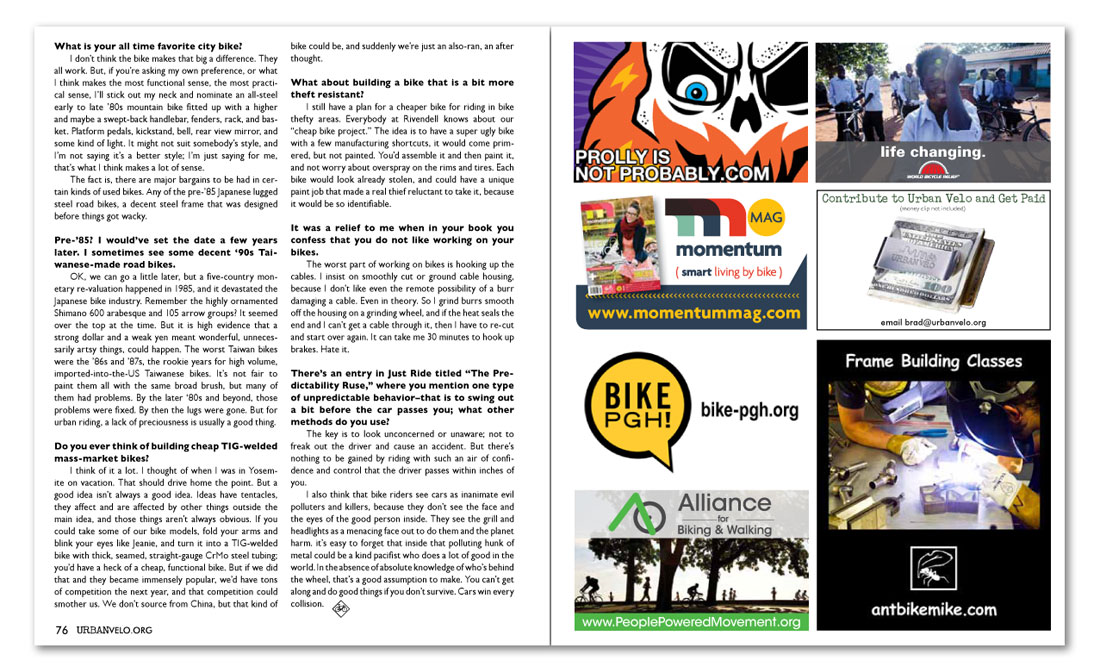


What is your all time favorite city bike?
I don’t think the bike makes that big a difference. They all work. But, if you’re asking my own preference, or what I think makes the most functional sense, the most practical sense, I’ll stick out my neck and nominate an all-steel early to late ’80s mountain bike fitted up with a higher and maybe a swept-back handlebar, fenders, rack, and basket. Platform pedals, kickstand, bell, rear view mirror, and some kind of light. It might not suit somebody’s style, and I’m not saying it’s a better style; I’m just saying for me, that’s what I think makes a lot of sense.
The fact is, there are major bargains to be had in certain kinds of used bikes. Any of the pre-’85 Japanese lugged steel road bikes, a decent steel frame that was designed before things got wacky.
Pre-’85? I would’ve set the date a few years later. I sometimes see some decent ‘90s Taiwanese-made road bikes.
OK, we can go a little later, but a five-country monetary re-valuation happened in 1985, and it devastated the Japanese bike industry. Remember the highly ornamented Shimano 600 arabesque and 105 arrow groups? It seemed over the top at the time. But it is high evidence that a strong dollar and a weak yen meant wonderful, unnecessarily artsy things, could happen. The worst Taiwan bikes were the ’86s and ’87s, the rookie years for high volume, imported-into-the-US Taiwanese bikes. It’s not fair to paint them all with the same broad brush, but many of them had problems. By the later ‘80s and beyond, those problems were fixed. By then the lugs were gone. But for urban riding, a lack of preciousness is usually a good thing.
Do you ever think of building cheap TIG-welded mass-market bikes?
I think of it a lot. I thought of when I was in Yosemite on vacation. That should drive home the point. But a good idea isn’t always a good idea. Ideas have tentacles, they affect and are affected by other things outside the main idea, and those things aren’t always obvious. If you could take some of our bike models, fold your arms and blink your eyes like Jeanie, and turn it into a TIG-welded bike with thick, seamed, straight-gauge CrMo steel tubing; you’d have a heck of a cheap, functional bike. But if we did that and they became immensely popular, we’d have tons of competition the next year, and that competition could smother us. We don’t source from China, but that kind of bike could be, and suddenly we’re just an also-ran, an after thought.
What about building a bike that is a bit more theft resistant?
I still have a plan for a cheaper bike for riding in bike thefty areas. Everybody at Rivendell knows about our “cheap bike project.” The idea is to have a super ugly bike with a few manufacturing shortcuts, it would come primered, but not painted. You’d assemble it and then paint it, and not worry about overspray on the rims and tires. Each bike would look already stolen, and could have a unique paint job that made a real thief reluctant to take it, because it would be so identifiable.
It was a relief to me when in your book you confess that you do not like working on your bikes.
The worst part of working on bikes is hooking up the cables. I insist on smoothly cut or ground cable housing, because I don’t like even the remote possibility of a burr damaging a cable. Even in theory. So I grind burrs smooth off the housing on a grinding wheel, and if the heat seals the end and I can’t get a cable through it, then I have to re-cut and start over again. It can take me 30 minutes to hook up brakes. Hate it.
There’s an entry in Just Ride titled “The Predictability Ruse,” where you mention one type of unpredictable behavior–that is to swing out a bit before the car passes you; what other methods do you use?
The key is to look unconcerned or unaware; not to freak out the driver and cause an accident. But there’s nothing to be gained by riding with such an air of confidence and control that the driver passes within inches of you.
I also think that bike riders see cars as inanimate evil polluters and killers, because they don’t see the face and the eyes of the good person inside. They see the grill and headlights as a menacing face out to do them and the planet harm. it’s easy to forget that inside that polluting hunk of metal could be a kind pacifist who does a lot of good in the world. In the absence of absolute knowledge of who’s behind the wheel, that’s a good assumption to make. You can’t get along and do good things if you don’t survive. Cars win every collision.